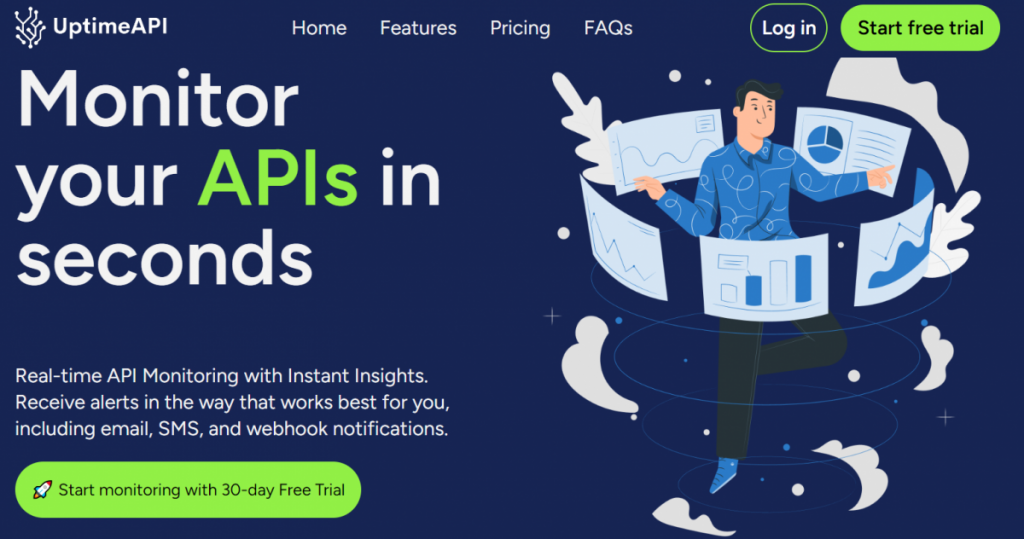In the fast-paced world of software development, ensuring the continuous availability of APIs is a top priority. Downtime can adversely impact user experience and, in turn, a company’s reputation. UptimeAPI provides developers with a robust solution for monitoring API health and receiving timely downtime alerts. In this quick guide, we’ll explore the importance of API downtime alerts and provide developers with essential insights into interpreting the API responses generated by UptimeAPI.
Understanding the Significance of API Downtime Alerts

1. Real-Time Issue Detection
API downtime alerts act as a real-time monitoring mechanism, instantly notifying developers when an API endpoint experiences disruptions. This allows for swift issue detection and minimizes the time it takes to respond, ensuring a seamless user experience.
2. Proactive Problem Resolution
Proactive resolution is key in the world of software development. API downtime alerts empower developers to identify and address issues before they escalate, preventing potential financial losses and safeguarding the reputation of the application.
3. User Satisfaction and Retention
In an era where users expect applications to be available 24/7, downtime can lead to dissatisfaction and even user abandonment. Downtime alerts enable developers to keep their finger on the pulse of API performance, ensuring users enjoy a reliable and uninterrupted experience.
UptimeAPI: Quick Integration for Downtime Alerts

Read More: Company profile APIUsage Cases
1. Getting Started with UptimeAPI
Sign Up and Obtain API Key
Begin by signing up for UptimeAPI and obtaining your API key. This key is your gateway to integrating UptimeAPI with your application. The signup process is user-friendly, allowing you to quickly access the monitoring features.
Install UptimeAPI SDK
Choose the SDK that matches your programming language and follow the straightforward installation instructions provided in the UptimeAPI documentation. Whether you’re using JavaScript, Python, or another language, UptimeAPI offers SDKs for seamless integration.
2. Configuring Downtime Alerts
Set Alerting Thresholds
Configure downtime alerts by setting thresholds based on parameters such as response time, error rate, or downtime duration. Customizing alerting criteria ensures that you receive notifications tailored to the specific needs of your application.
Choose Notification Channels
UptimeAPI supports various notification channels, including email, SMS, and integrations with popular collaboration tools like Slack. Choose the channels that best fit your team’s workflow to ensure timely communication of downtime incidents.
3. Interpreting UptimeAPI API Responses
When an API endpoint experiences downtime, UptimeAPI generates an API response that provides essential information for developers. Let’s break down what a typical API response might look like:
{
"status": "failure",
"timestamp": "2024-01-17T15:30:00Z",
"endpoint": "https://api.example.com",
"downtime_duration": 300,
"error_message": "Connection timeout"
}
Key Components of the API Response:- status: Indicates the status of the API request to UptimeAPI. In this case, “failure” signifies downtime.
- timestamp: Provides the date and time of the API response.
- endpoint: Specifies the monitored API endpoint that experienced downtime.
- downtime_duration: Represents the duration of the downtime in seconds.
- error_message: Offers a brief description of the error that caused the downtime.
4. Quick Troubleshooting with UptimeAPI Responses
Upon receiving a downtime alert, developers can quickly troubleshoot the issue using the information provided in the API response. The timestamp helps identify when the downtime occurred, and the error message provides insights into the nature of the problem, expediting the resolution process.
Conclusion
API downtime alerts are the unsung heroes of a robust and reliable software infrastructure. UptimeAPI simplifies the integration of downtime alerts into your development workflow, offering a quick and efficient solution for developers. By following this quick guide, you can swiftly set up UptimeAPI, configure downtime alerts, and interpret API responses to ensure the continuous availability of your APIs.
In the competitive landscape of software development, where user satisfaction is paramount, UptimeAPI emerges as a valuable ally. Empower your development team with the tools needed to detect and resolve issues promptly, providing users with an uninterrupted and enjoyable experience. Integrate UptimeAPI today, and stay ahead of potential downtime challenges in your API ecosystem.

